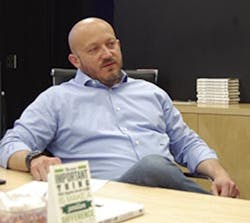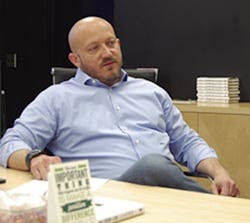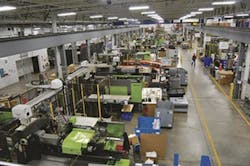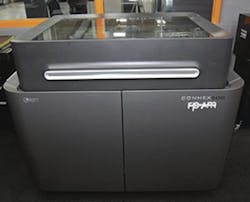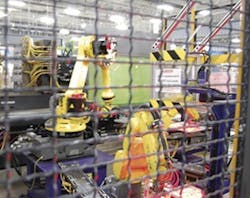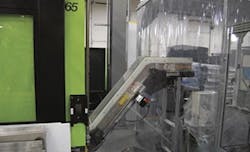Seeking excellence, Thogus adds value across the board
Constant innovation is the primary strategy CEO Matt Hlavin uses at his company to stay ahead. The third-generation owner of injection molder Thogus Products is matter-of-fact about this approach.
"There are 8,000 molders in the U.S.," he said. "There are 22,000 molders worldwide. How do you differentiate yourself as a job shop or contract manufacturer? We really look at that bigger picture to understand true end to end. How do we bring value each and every day? How do we value- engineer that? It's not just a cliché term; we live by that. It is all facets and all levels of the organization. It's not just engineering. A lot of innovation here or changes come from our customer service group, it comes from shipping and receiving, it comes from the operators on the machines, it comes from the quality people."
Machinery and equipment innovation are in evidence everywhere at the company's headquarters facility in Avon Lake, Ohio, about 25 miles west of Cleveland. Eleven 3-D printers are at work alongside 40 injection molding machines with various levels of automation. The company performs two-shot molding, insert molding and full encapsulation molding. In one example of full encapsulation molding, Thogus overmolds a magnet containing neodymium that's used in slushie machines to keep them spinning.
"We have neodymium glued to rings and then we fully encapsulate around it with Kynar, which is a thermoplastic fluoropolymer," Hlavin said. "You literally are flowing the polymer over the pins that are holding it. So the pins drop and the flow front goes right over it." A 65-ton Engel rotary press runs the parts.
On the day of Plastics Machinery Magazine's tour, an Objet500 Connex 3-D printer was building a phone case from a photopolymer for a prototype. Hlavin explained that in traditional injection molding, two-shot molding would have been used, but that is a very expensive tool for prototyping. The Objet Connex model can print up to 17 materials simultaneously, enabling the company to print the prototype in a few hours, compared with eight weeks in traditional injection molding.
"Sur La Table wants a different feel than Williams Sonoma or Costco, so rather than investing in all that cap[ital] ex[penditure] in the tools, you're just printing," Hlavin said. "You have to get to market faster, and you lower your risk."
Automate to innovate
Innovations in automation also are on display throughout the facility. One cell makes use of three six-axis Fanuc robots in an operation that allows for automatic placement of blades onto a tape dispenser.
For years, the client had the dispenser injection molded, then moved to another cell where the blade was ultrasonically welded. When Thogus was approached for the program, Hlavin and his team considered the opportunity and how the company could compete, as well as the volume it could produce. The volume at that time was just under 10 million units annually. Now, the company makes more than 13 million units a year.
"We said we wanted to be able to automate the process," Hlavin said. "If a part is being produced and it's a commodity part, you've got to be able to compete domestically, as well as globally. We took a hard look at it and said, 'How do we get it? How do we win the program?' You have to automate."
When making 13 million to 20 million parts, how does a company optimize its efficiency? Thogus modified how the project was handled. That included taking the existing molds and retrofitting them. An injection molding machine without tiebars also was necessary to accommodate the robots. Thogus designed and built a cell with a 330-ton tie-bar-less Engel and the three Fanucs, allowing the cell to run 24 hours a day, seven days a week, with no labor.
"There is a lot of engineering that goes into this little part," he said of the tape dispenser. "Understanding the tiebarless, we have a large six-axis Fanuc going in and placing blades into the cavities. If there was a tiebar there, it would have been very difficult to do that."
The cell involves eight cameras. The two smallest robots stage the metal inserts, taking the blades and putting them on a tray. The bigger robot then puts the inserts into mold.
"If you look at the labor, what value is the employee putting into the part? Nothing. They are touching it and they're moving it, they're just putting something there, then another function has to happen. It doesn't add value," he said. "That is where China and Mexico and the low-cost nations beat us is if (we're using) non-value-added labor. We went all the way through the process to look at, how do we lower cost overall?"
On this project, Thogus also questioned how the products were colored. The company's major contract calls for a specific shade of blue, but other clients require colors such as red, green, natural and white. The clients want consistency in their colors.
"If we have to mix, even with these great gravimetric blenders out there, there is variability," Hlavin said.
Thogus worked with a materials company to customize liquid colorant that was compatible with the wide-spec HIPS used in the products. HIPS and liquid colorant usually mix poorly, but the specialized formula produces consistent color, and Thogus can now do more with less — it's cut its liquid-colorant requirements by more than 90 percent. In addition, to protect the tape dispenser's colors, Thogus and the materials company increased the amount of UV stabilizers in the product. That way, if the product sits on a shelf for two years, there is no distinguishable difference between it and a freshly made dispenser sitting next to it.
Elsewhere on the plant floor, as part of a contract from a maker of deluxe kitchen blenders, a cell was molding a clear polyester pitcher on a 420-ton Engel equipped with a Yushin Cartesian robot. With any clear material, there is an optical standard. This client, though, wants its customers to have the Apple experience — a pristine appearance, without fish hooks or imperfections.
In order to achieve that, the pitcher is exposed to fire. Thogus created a fully automated process where the pitchers are flamed on the outside and the inside so there are no visual imperfections and no labor is involved at all. Within the molding cell, there are two electric flame units. The pitchers are transferred to the first flame unit, where the inside is flamed; then the pitcher is transferred to its second stage where the outside is flamed. Thogus then wraps the pitchers in cheesecloth and sends them to the blender maker.
This automation involved end-of-arm tooling (EOAT) that was designed by Thogus. "We'll build additional functions and sensing into the EOAT," Hlavin said. "So it can articulate in different ways. We started building our own internal automation team because automation is becoming a core competency to our business and outside firms. We cannot afford the downtime to wait for their support team to arrive when we have issues by using a third party to do it; we found that too limiting. If something breaks down and they're not here, we have to wait. Now we're not running. We are like Southwest with no butts in the seats. So with our set-up, process and material handling team, we are starting to teach them basics in automation so they can troubleshoot. If they are successful and have a passion for this work, we'll build out a whole track for him or her to attend automation training courses."
Flexibility is key
With all the machinery and equipment choices Thogus has, flexibility is key. As the owner, Hlavin has influence over machinery and equipment investment choices, and he makes the final decision if the cost exceeds a certain amount.
"But it's really done by a group, a committee. It's between engineering, maintenance, production, finance and operations. So they build a business case," he said.
The key is the flexibility of the machinery. How could the equipment or machinery be used if something happened to the project for which it originally was intended? For example, Thogus is molding a part for a start-up company that requires a Class 7 clean room.
"They do not have a firm forecast because they are launching into the market," he said. "You have to look at the opportunity and weigh the risk vs. the reward.
"You could build a room, build a field of dreams, and the dream doesn't come. What it then becomes is a very expensive R&D tax credit," he said.The product is a container for a liquid-suspended formulation sold through compounding pharmacies.
"Typically, what you do is you build a building or a room that qualifies to that. That is a major budget to build out a room like that. It can cost you a half million bucks to do that. But we had an existing machine, a 165-ton Engel tie-bar-less hydraulic. Typically, in a clean room, you cannot have hydraulic machines."
To meet those challenges, Thogus actually designed a clean room — that sits atop the machine. A specially made, hermetically sealed frame sits above the machine, between the platens; stainless steel plates encapsulate the platens, sealing off the area from oil leaks.
"We basically sealed the whole press off," Hlavin said. "Your materials that touch, materials that are in the manufacturing environment, have to meet the Class 7 requirement," he said. "We created a positive-pressure kind of chamber that sits on top that flows through. It ensures that a particulate doesn't get on the part, and doesn't get into the process. It's on top of the molding machine."
Parts are molded and then fall onto a conveyor. The conveying system is completely sealed with positive air pressure that meets the Class 7 requirement. The air pushes the product into a clean-room assembly area. Any material that goes in there is in a sealed container.
"The reason we have a person in there is that the volume is not high enough to fully automate it," Hlavin said. "Therefore, we are feeding the automation cell itself. We take a bottle, we take a cap, and then we weld it together, and you have your pill-bottle caps, those safety caps are automatically turned on to the part. So that is automated. We didn't have to buy a brand-new machine, we didn't have to buy a brand-new room to do that. If the deal were not to come to fruition, we can break everything up and repurpose it somewhere else. All of those assets can be repurposed," he said.
Angie DeRosa, managing editor
Just the facts
COMPANY: Thogus Products Co.HEADQUARTERS: Avon Lake, OhioOWNER: Matt HlavinFOUNDED: 1950 by Jack Thompson (Hlavin's grandfather) and Walter GusEMPLOYEES: 127ANNUAL SALES: $30 million
Contact
Thogus Products Co.,Avon Lake, Ohio, 440-933-8850, www.thogus.com
